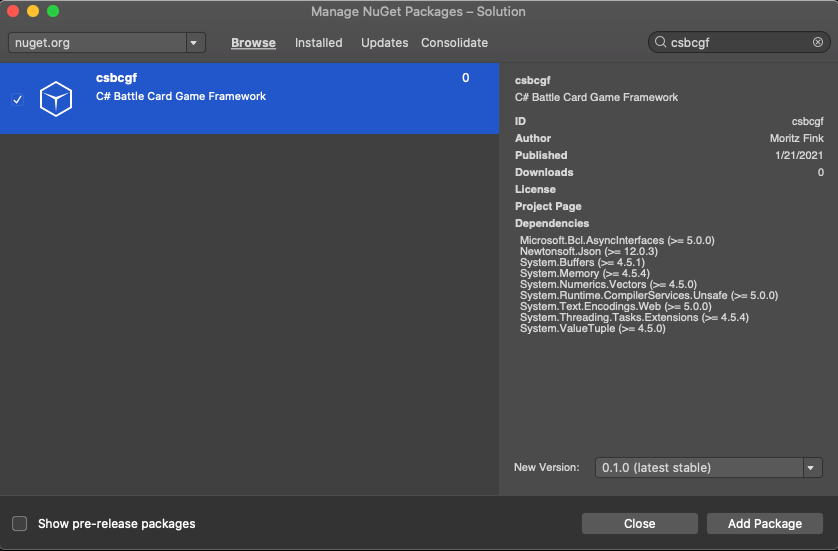2. The Basics
Before we are actually implementing our first class with the CSBCGF, we should get a quick
overview on the framework's basic game structure and mechanics.
2.1 Game Structure
Most battle card game have a pretty similar setup and we try to resemble this within the
CSBCGF. A game consists of an arbitrary amount of players (but usually two). Each player has a deck
(initially) containing all his/her cards. Each player also has a hand that can hold a certain amount
of cards, a board with a certain amount of slots - which can in turn be occupied by a card or not - and
a graveyard where cards can be discarded to.
This basic setup can easily achieved with a few lines of code:
using csbcgf;
namespace csbcgftutorial
{
class MainClass
{
public static void Main(string[] args)
{
IGame myGame = new Game();
IPlayer myPlayer1 = new Player();
IPlayer myPlayer2 = new Player();
myGame.Players.Add(myPlayer1);
myGame.Players.Add(myPlayer2);
}
}
}
A player has a life stat and a mana pool stat that we can access as follows:
Console.WriteLine("Life stat of player 1 = " + myPlayer1.LifeValue
+ " / " + myPlayer1.LifeBaseValue);
Console.WriteLine("Mana pool stat of player 1 = " + myPlayer1.ManaValue
+ " / " + myPlayer1.ManaBaseValue);
You should notice that each stat consists of a value and a base value. In the case of the life stat,
the base value represents a players full life and the value his/her current life points. In the case
of the mana pool stat, the base value represents how much mana is available to the player at the
start of each turn and the value counts how much of it is still left.
2.2 Cards
The most important ingredients of each battle card game naturally are the cards. Those can be
categorized into two different kinds: monster cards & spell cards.
Both have a mana cost stat that represents the amount of mana a player has to spend in order to
bring the card into play.
Spell cards are played from a player's hand, alter the game's state, i.e. they have an
effect and are afterwards discarded to the player's graveyard.
Monster cards are played from a player's hand onto his/her side of the board. They have a
life stat and an attack stat. A player can attack an opponent player or one of his/her monster cards
on the board with one of his/her monster cards on the board. This decreases the life stats of the
defending and attacking character (i.e. player or monster) by the amount of attack points of the
other character respectively. Once a monster card's life drops to zero it is discarded to the
owning player's graveyard. If a player's life drops to zero this player looses the game.
Let us start by initializing a simple monster card that costs one mana and has one attack point and one
life point respectively:
IMonsterCard myMonsterCard = new MonsterCard(
mana: 1,
attack: 1,
life: 1
);
2.3 Card Collections
Card Collections provide a convenient way to hold multiple cards in one place. There are three
different types:
- Hand: Represents a player's hand
- Deck: Represents a player's deck
- Board: Represents a player's board with slots for monster cards
Before starting a game the player's deck should be set up in the following way:
IDeck deck = new Deck();
for (int i = 0; i < 20; ++i)
{
IMonsterCard myMonsterCard = new MonsterCard(mana: 1, attack: 1, life: 1);
deck.Push(myMonsterCard);
}
2.4 Players
Players must be initialized with the deck that we previously setup:
List<IPlayer> players = new List<IPlayer>();
for (int i = 0; i < 2; ++i)
{
IDeck deck = new Deck();
// TODO: Push some cards into the deck
players.Add(new Player(deck));
}
2.5 Game
Finally, we can create and start a game involving those players:
IGame game = new Game(players);
game.StartGame(initialHandSize: 1, initialPlayerLife: 2);
By calling the StartGame method, every player receives the given number
(initialHandSize) of cards from their deck to their hand. Each player starts
with initialPlayerLife life points. At this point the game is on and the first
turn has started. The (randomly chosen) active player (game.ActivePlayer) may now
perform a set of actions that will be discussed later on. The turns ends with a call to
game.NextTurn().
During a turn the players may use their resources to perform following actions:
Summon a monster
The active player spends the monster card's mana costs and transfers it from his/her hand to
the board (onto the specified slot):
IPlayer activePlayer = game.ActivePlayer;
Console.WriteLine("Active player's mana = " + activePlayer.ManaValue);
IMonsterCard goblin = (IMonsterCard)activePlayer.Hand[0];
if(goblin.IsSummonable(game))
{
activePlayer.CastMonster(game, goblin, 0);
Console.WriteLine("Active player's mana = " + activePlayer.ManaValue);
}
Cast a spell
The active player spends the spell card's mana costs, the card's effects are played and the
card moves to the graveyard. Since we have not discussed spell cards in detail at this point
in the tutorial, we will just leave the following snippet here for demonstration purpose and
come back to it later:
ISpellCard spell = (ISpellCard)activePlayer.Hand[1];
if(spell.IsCastable(game))
{
if(spell is ITargetlessSpellCard targetlessSpell)
{
activePlayer.CastSpell(game, targetlessSpell);
}
else if (spell is ITargetfulSpellCard targetfulSpell)
{
activePlayer.CastSpell(game, targetfulSpell, goblin);
}
}
Attack
If the active player possesses a monster on his/her board that has not been summoned in this turn
and not attacked yet in this turn, then this monster may attack an opposing player or a
monster on an opponent's board. Attacking a player reduces this player's life by the attack points
of the attacking monster. Attacking another monster reduces both monsters' lifes by the other monster's
attack points.
if(goblin.IsReadyToAttack)
{
goblin.Attack(game, game.NonActivePlayers[0]);
// OR
goblin.Attack(game, anotherGoblin);
}
During the game you may want to check if a certain player is still alive:
Console.WriteLine("First player is still alive: " + game.Players[0].IsAlive);
